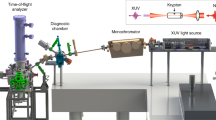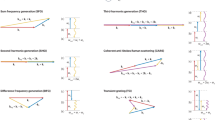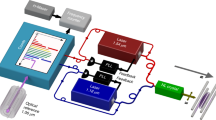Abstract
Electron paramagnetic resonance (EPR) spectroscopy interrogates unpaired electron spins in solids and liquids to reveal local structure and dynamics; for example, EPR has elucidated parts of the structure of protein complexes that other techniques in structural biology have not been able to reveal1,2,3,4. EPR can also probe the interplay of light and electricity in organic solar cells5,6,7 and light-emitting diodes8, and the origin of decoherence in condensed matter, which is of fundamental importance to the development of quantum information processors9,10,11,12,13. Like nuclear magnetic resonance, EPR spectroscopy becomes more powerful at high magnetic fields and frequencies, and with excitation by coherent pulses rather than continuous waves. However, the difficulty of generating sequences of powerful pulses at frequencies above 100 gigahertz has, until now, confined high-power pulsed EPR to magnetic fields of 3.5 teslas and below. Here we demonstrate that one-kilowatt pulses from a free-electron laser can power a pulsed EPR spectrometer at 240 gigahertz (8.5 teslas), providing transformative enhancements over the alternative, a state-of-the-art ∼30-milliwatt solid-state source. Our spectrometer can rotate spin-1/2 electrons through π/2 in only 6 nanoseconds (compared to 300 nanoseconds with the solid-state source). Fourier-transform EPR on nitrogen impurities in diamond demonstrates excitation and detection of EPR lines separated by about 200 megahertz. We measured decoherence times as short as 63 nanoseconds, in a frozen solution of nitroxide free-radicals at temperatures as high as 190 kelvin. Both free-electron lasers and the quasi-optical technology developed for the spectrometer are scalable to frequencies well in excess of one terahertz, opening the way to high-power pulsed EPR spectroscopy up to the highest static magnetic fields currently available.
This is a preview of subscription content, access via your institution
Access options
Subscribe to this journal
Receive 51 print issues and online access
$199.00 per year
only $3.90 per issue
Buy this article
- Purchase on Springer Link
- Instant access to full article PDF
Prices may be subject to local taxes which are calculated during checkout




Similar content being viewed by others
References
Hubbell, W. L., Mchaourab, H. S., Altenbach, C. & Lietzow, M. A. Watching proteins move using site-directed spin labeling. Structure 4, 779–783 (1996)
Pannier, M., Veit, S., Godt, A., Jeschke, G. & Spiess, H. W. Dead-time free measurement of dipole-dipole interactions between electron spins. J. Magn. Reson. 142, 331–340 (2000)
Saxena, S. & Freed, J. H. Double quantum two dimensional Fourier transform electron spin resonance: distance measurements. Chem. Phys. Lett. 251, 102–110 (1996)
Borbat, P. & Freed, J. H. Multiple-quantum ESR and distance measurements. Chem. Phys. Lett. 313, 145–154 (1999)
Smilowitz, L. et al. Photoexcitation spectroscopy of conducting polymer-C60 composites: photoinduced electron transfer. Phys. Rev. B 47, 13835–13842 (1993)
Dyakonov, V. et al. Photoinduced charge carriers in conjugated polymer-fullerene composites studied with light-induced electron-spin resonance. Phys. Rev. B 59, 8019–8025 (1999)
Ogiwara, T., Ikoma, T., Akiyama, K. & Tero-Kubota, S. Spin dynamics of carrier generation in a photoconductive C60-doped poly(N-vinylcarbazole) film. Chem. Phys. Lett. 411, 378–383 (2005)
McCamey, D. R. et al. Spin Rabi flopping in the photocurrent of a polymer light-emitting diode. Nature Mater. 7, 723–728 (2008)
Takahashi, S., Hanson, R., van Tol, J., Sherwin, M. S. & Awschalom, D. D. Quenching spin decoherence in diamond through spin bath polarization. Phys. Rev. Lett. 101, 047601 (2008)
Gruber, A. et al. Scanning confocal optical microscopy and magnetic resonance on single defect centers. Science 276, 2012–2014 (1997)
Lyon, S. A. Spin-based quantum computing using electrons on liquid helium. Phys. Rev. A 74, 052338 (2006)
Hanson, R., Kouwenhoven, L. P., Petta, J. R., Tarucha, S. & Vandersypen, L. M. K. Spins in few-electron quantum dots. Rev. Mod. Phys. 79, 1217–1265 (2007)
Takahashi, S. et al. Decoherence in crystals of quantum molecular magnets. Nature 476, 76–79 (2011)
Freed, J. H. New technologies in electron spin resonance. Annu. Rev. Phys. Chem. 51, 655–689 (2000)
Earle, K. A., Dzikovski, B., Hofbauer, W., Moscicki, J. K. & Freed, J. H. High-frequency ESR at ACERT. Magn. Reson. Chem. 43, S256–S266 (2005)
van Tol, J. et al. High-field phenomena of qubits. Appl. Magn. Reson. 36, 259–268 (2009)
Hofbauer, W., Earle, K. A., Dunnam, C. R., Moscicki, J. K. & Freed, J. H. High-power 95 GHz pulsed electron spin resonance spectrometer. Rev. Sci. Instrum. 75, 1194–1208 (2004)
Cruickshank, P. A. S. et al. A kilowatt pulsed 94 GHz electron paramagnetic resonance spectrometer. with high concentration sensitivity, high instantaneous bandwidth, and low dead time. Rev. Sci. Instrum. 80, 103102 (2009)
Communications and Power Industries (CPI). http://www.cpii.com/product.cfm/7/40
Nanni, E. A., Shapiro, M. A., Sirigiri, J. R. & Temkin, R. J. Design of a 250 GHz photonic band gap gyrotron amplifier. 2010 IEEE Int. Vacuum Electron. Conf. http://dx.doi.org/10.1109/IVELEC.2010.5503423 (IEEE, 2010)
Ramian, G. the new UCSB free-electron lasers. Nucl. Instrum. Methods Phys. A 318, 225–229 (1992)
Takahashi, S., Ramian, G., Sherwin, M. S., Brunel, L.-C. & van Tol, J. Submegahertz linewidth at 240 GHz from an injection-locked free-electron laser. Appl. Phys. Lett. 91, 174102 (2007)
Takahashi, S., Ramian, G. & Sherwin, M. S. Cavity dumping of an injection-locked free-electron laser. Appl. Phys. Lett. 95, 234102 (2009)
Hegmann, F. A. & Sherwin, M. S. Generation of picosecond far-infrared pulses using laser-activated semiconductor reflection switches. Proc. SPIE 2842, 90–105 (1996)
Doty, M. F., Cole, B. E., King, B. T. & Sherwin, M. S. Wavelength-specific laser-activated switches for improved contrast ratio in generation of short THz pulses. Rev. Sci. Instrum. 75, 2921–2925 (2004)
Rolland, C. & Corkum, P. B. Generation of 130-fsec midinfrared pulses. J. Opt. Soc. Am. B 3, 1625–1629 (1986)
Mitsudo, S. et al. Development of a sub-THz cw gyrotron for the millimeter wave pulsed ESR spectrometer. Proc. IRMMW-THz 2010http://dx.doi.org/10.1109/ICIMW.2010.5612381 (IEEE, 2010)
Smith, G. M., Lesurf, J. C. G., Mitchell, R. H. & Riedi, P. C. Quasi-optical cw mm-wave electron spin resonance spectrometer. Rev. Sci. Instrum. 69, 3924–3937 (1998)
van Tol, J., Brunel, L.-C. & Wylde, R. J. A quasioptical transient electron spin resonance spectrometer operating at 120 and 240 GHz. Rev. Sci. Instrum. 76, 074101 (2005)
Rabi, I. I. Space quantization in a gyrating magnetic field. Phys. Rev. 51, 652–654 (1937)
Acknowledgements
This work was supported by the NSF (CHE-0821589, DMR-0520481 and DMR-0703925) and the W. M. Keck Foundation. We thank D. Enyeart, S. El Abbadi, N. Krauss, K. Akabori, M. Anholm, T. Visher, J. Bricker and G. Kontsevich for support of the development and operation of the FEL.
Author information
Authors and Affiliations
Contributions
S.T. and M.S.S. contributed to the writing of the manuscript. M.S.S., S.H., L.-C.B. and J.v.T. conceived the development of the FEL-powered EPR spectrometer. The development was carried out by S.T., D.T.E., G.R., L.-C.B., S.H. and M.S.S. S.T., D.T.E., J.v.T. and M.S.S. conceived the EPR experiments. The measurements were carried out by S.T., D.T.E. and L.-C.B.
Corresponding author
Ethics declarations
Competing interests
The authors declare no competing financial interests.
Supplementary information
Supplementary Information
This file contains Supplementary Text, Supplementary Figures 1-5 and Supplementary References. (PDF 358 kb)
Rights and permissions
About this article
Cite this article
Takahashi, S., Brunel, LC., Edwards, D. et al. Pulsed electron paramagnetic resonance spectroscopy powered by a free-electron laser. Nature 489, 409–413 (2012). https://doi.org/10.1038/nature11437
Received:
Accepted:
Published:
Issue Date:
DOI: https://doi.org/10.1038/nature11437
This article is cited by
-
Low Power Demonstration of a W-band Active Pulse Compressor for High Power Millimeter Waves
Journal of Infrared, Millimeter, and Terahertz Waves (2022)
-
Spin current from sub-terahertz-generated antiferromagnetic magnons
Nature (2020)
-
Gyrotrons for High-Power Terahertz Science and Technology at FIR UF
Journal of Infrared, Millimeter, and Terahertz Waves (2017)
-
High-frequency and high-field electron paramagnetic resonance (HFEPR): a new spectroscopic tool for bioinorganic chemistry
JBIC Journal of Biological Inorganic Chemistry (2014)
Comments
By submitting a comment you agree to abide by our Terms and Community Guidelines. If you find something abusive or that does not comply with our terms or guidelines please flag it as inappropriate.



